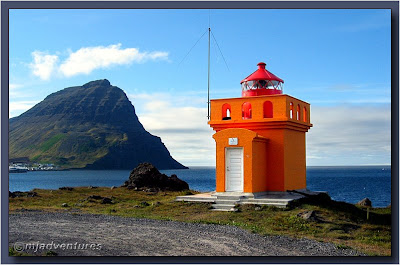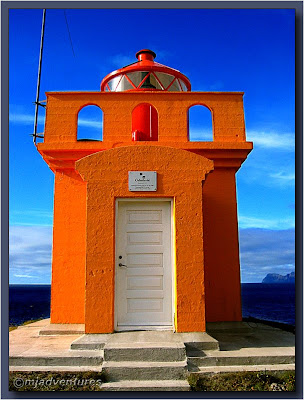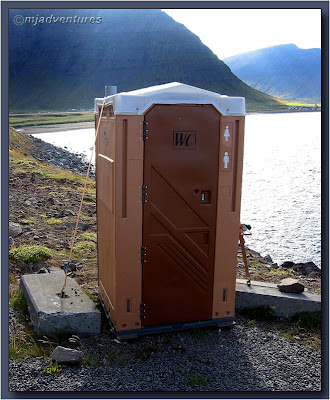Click images to enlarge
By the time we had finished breakfast, we were kicking ourselves for not staying another night in Hesteyri and taking the evening ferry back to Ísafjörður as our friends C & F were doing. The Bolungarvik ferry had been arranged by J's friend before we had arrived in Iceland and, as we weren't familiar with the area or the ferry timings, we had gone along with the plans.
However, the apartment in Bolungarvik was costing us €240 for the 2 nights and it was annoying us that we had to spend another whole day and night in Bolungarvik, twiddling our thumbs until the next morning when our plane flew out of Ísafjörður. We were stuck - no transportation to go anywhere and if we did fly out a day earlier, we then had to find even more expensive accommodation in Reykjavik/Keflavik for an extra night. Damn!
When I had gone down to the wharf to photograph the boats the previous evening, I had also checked out the local bus service timetable between Bolungarvik and Ísafjörður. There were only 3 trips per day both ways, so we didn't have much choice.
After breakfast, the kids went fishing with the son of J's friend, so that got them out of our hair for the day. J and I decided to head into Ísafjörður for something to do - plus we had to stop at the Information Centre to arrange our early morning airport shuttle pick-up.
We caught the 1pm shuttle to Ísafjörður and 15 minutes later, we were at the Information Centre arranging the shuttle for the next morning. After doing that, we decided to walk around the town to see what we could find.
 The inner fjörd with the main wharf area
The inner fjörd with the main wharf areaAnother cruise ship was in port. Smaller than the QE2, it was able to tie up at the wharf. From the accents that we heard from its passengers who were walking around town, the Silver Cloud was filled with Americans.
By now we had managed to fill in an hour to reach 2:15pm. The shuttle bus back to Bolungarvik wasn't due to leave until 6pm. What the hell were we going to do for the next 3.75 hours?
Desperate people do desperate things. We decided to walk back to Bolungarvik.
It.was.only.15.kilometres.away.
We set off along the Óshlíd road, fighting a cold headwind the whole way. My feet, knees and right hip had not fully recovered from the Hesteyri hiking, so I was taking a battering. Still, it was better than trying to fill in time while waiting for the shuttle.
Along the way, we did see some pretty sights including a few waterfalls.
 We also saw a seal fishing off the rocks and there were quite a few birds to watch as well. Plus, we had to look out for vehicles which passed close to us as there was no footpath and we were walking on the side of the road. The cliffs towering above reminded us of our off-road adventures in Oman - albeit a lot greener than the Hajjar Mountains.
We also saw a seal fishing off the rocks and there were quite a few birds to watch as well. Plus, we had to look out for vehicles which passed close to us as there was no footpath and we were walking on the side of the road. The cliffs towering above reminded us of our off-road adventures in Oman - albeit a lot greener than the Hajjar Mountains.After 2.25 hours, we came around the corner to see the lighthouse, and behind it was Bolungarvik. At least we could now see our destination! We paused to take photos of the lighthouse which was very vivid against the blue sky.
 As we passed the fishing village which is now a tourist attraction, we noticed this portable toilet on top of the cliff. To our amusement, it was tied down to 2 very heavy concrete slabs. We guess that it must get very windy at times!
As we passed the fishing village which is now a tourist attraction, we noticed this portable toilet on top of the cliff. To our amusement, it was tied down to 2 very heavy concrete slabs. We guess that it must get very windy at times!Finally, we were back in Bolungarvik. The town's sign was great motivation to keep going, even though we knew that we still had a couple of kms to go. It was now 6pm.
We detoured to the supermarket where we treated ourselves to ice creams before walking back to the apartment to put up our weary feet. Unfortunately the boys arrived home shortly after, demanding dinner. No rest for the walkers!
Next Chapter: Our last day and leaving Iceland










3 comments:
Καλή εβδομάδα να έχετε, με ένα ποίημα από τον Λορέντζο Μαβίλη
Have a nice week, with a poem by Lorenzo Mavilis
LETHE
Fortunate are the dead who forget
the bitterness of life. When the sun sets
and dusk follows, do not weep for them,
no matter how deep your sorrow may be!
At such an hour the souls are thirsty and go
to οblivion's crystal-cold spring;
but the water will turn muddy,
if a tear is shed for them by the beloved.
And if they drink turbid water, they recall,
passing through fields of asphodels,
past sorrows that sleep within them.
If you cannot but weep, at sunset,
your eyes should lament for the living
who seek to forget, but cannot do so.
'Lethe', or 'Oblivion' is a pessimistic poem. Mavilis mingles in it the ancient Greek belief about the Underworld, so well described by Homer in the Odyssey (XXIV, 1-14), and the Modern Greek tradition about the Realm of the Dead. According to Homer, the Underworld is a vast field where the plant asphodel grows.
ΛΗΘΗ
Καλότυχ' οι νεκροί, που λησμονάνε
την πίκρα της ζωής. Όντας βυθίσει
ο ήλιος και το σούρουπο ακλουθήσει,
μην τους κλαις, ο καημός σου όσος και να 'ναι!
Τέτοιαν ώρα οι ψυχές διψούν και πάνε
στης λησμονιάς την κρουσταλλένια βρύση.
Μα βούρκος το νεράκι θα μαυρίσει,
Σα στάξει γι' αυτές δάκρυ, όθε αγαπάνε.
Κι αν πιουν θολό νερό, ξαναθυμούνται
διαβαίνοντας λιβάδι' απ' ασφοδίλι,
πόνους παλιούς, που μέσα τους κοιμούνται.-
Α δε μπορείς παρά να κλαις, το δείλι,
τους ζωντανούς τα μάτια σου ας θρηνήσουν,
θέλουν -μα δε βολεί να λησμονήσουν.
Η "Λήθη" είναι απαισιόδοξο ποίημα. Ο Μαβίλης αναμειγνύει σ' αυτό την αρχαία ελληνική πίστη για τον Άδη, που με ενάργεια έχει περιγραφεί από τον Όμηρο στην Οδύσσεια (ραψ. κδ΄, 1-14), και την νεοελληνική παράδοση για τον Κάτω Κόσμο. Σύμφωνα με τον Όμηρο, ο Άδης είναι ένα απέραντο λιβάδι γεμάτο με ασφοδέλους.
Love the little orange lighthouse!
Cute, isn't it?
Post a Comment